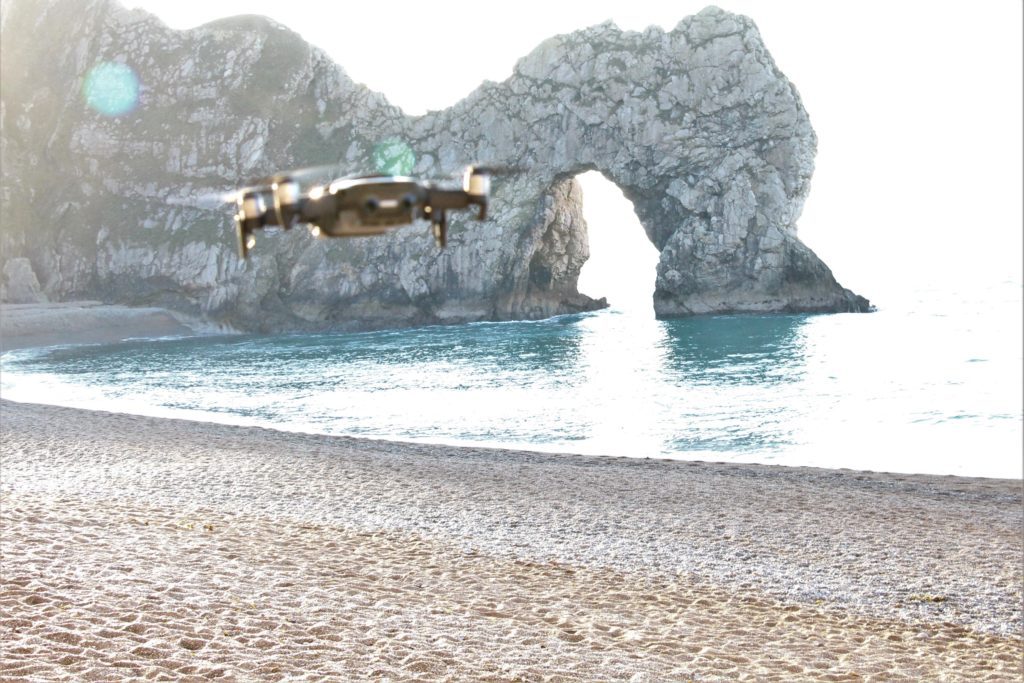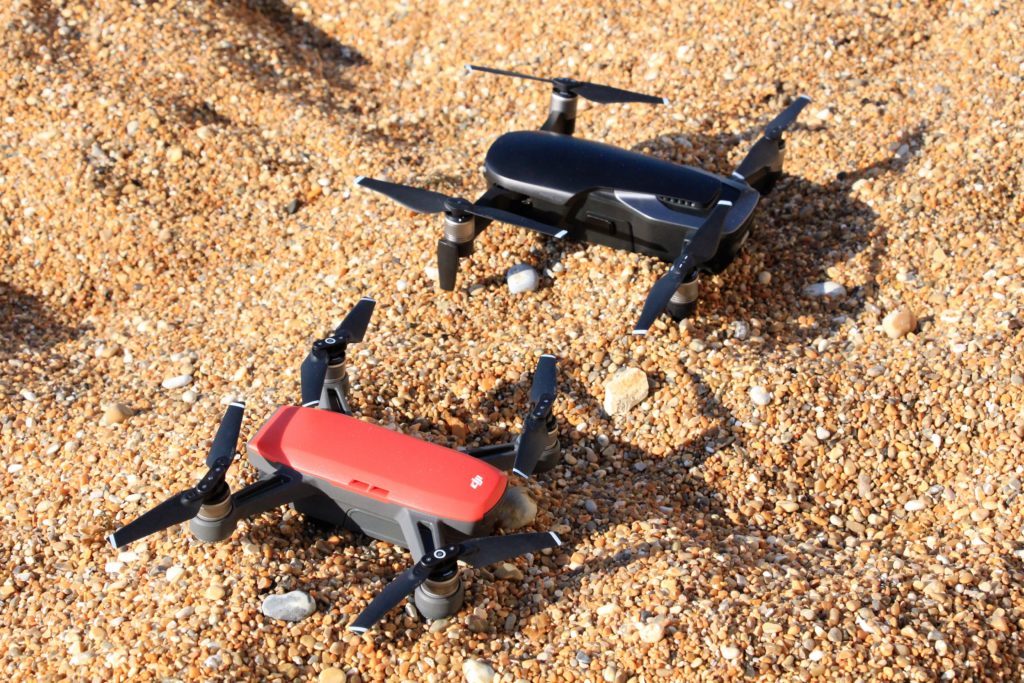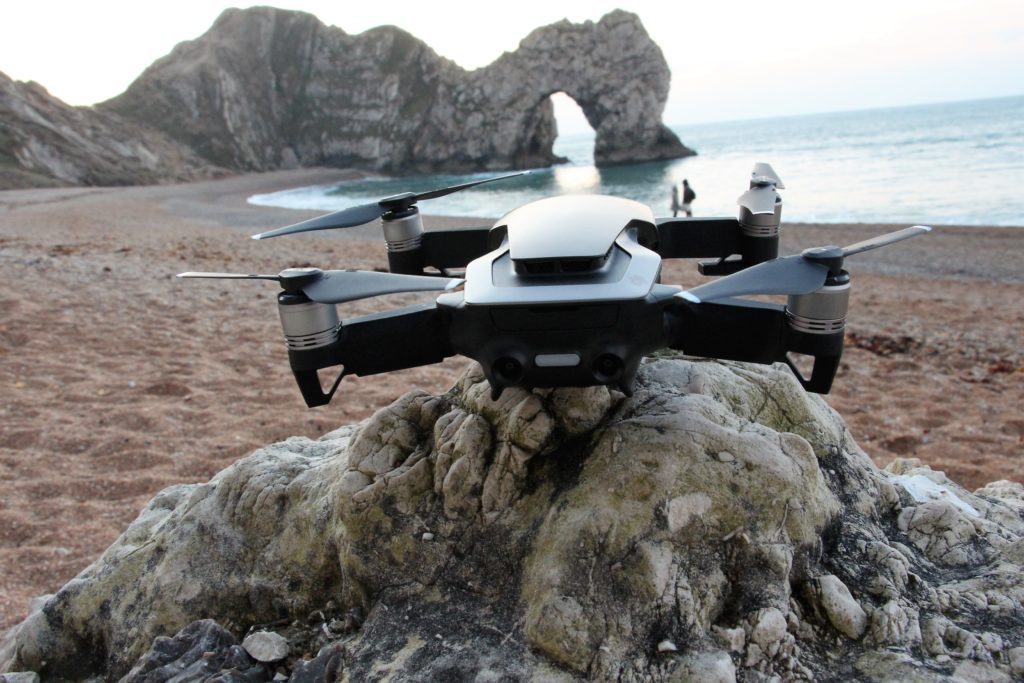DJI’s Mavic Air was announced at the end of January. Sure, it wasn’t exactly what we were expecting from the industry’s leading manufacturer. But that didn’t stop us from getting hold of one for a review.
We had our chance to fly it for the first time over the weekend. Below are the initial impressions and raw footage that we took while filming on England’s south coast.

The Mavic Air is a drone that promises plenty: portability, high-quality aerial photography, obstacle sensing in multiple directions – And that’s just the start. On paper it looks like it’ll give the more expensive Mavic Pro a run for its money.
And that’s no surprise. According to DJI’s Michael Perry, “The day after we started shipping the Mavic Pro we went back to the drawing board to create something entirely new.”
DJI only really have themselves for competition these days, so it makes sense for the Mavic Air to be the drone that consigns the Pro to the trash heap.
First Impressions
Figuring out where the Air stands in relation to the Mavic Pro and the Spark is tough. Size-wise it sits comfortably between the two. Ditto in terms of price. At $799, it’s $200 cheaper than the standard Mavic Pro and $400 more expensive than the Spark.
But in terms of specs it’s much closer to the Mavic Pro than the Spark. For example, in windy conditions we were getting just over 20 minutes per battery. Its camera houses a 1/2.3” CMOS sensor and the equivalent of a 24mm F2.8 lens, so it takes 12mp stills and can shoot 4k video.
DJI have also upgraded the Air with new HDR algorithms to preserve more highlight and low light details, so purely from a photography perspective, it should be competitive with the Mavic Pro.
Flying the Mavic Air
If you’ve never flown a DJI drone before, you’ll probably be taken aback by its stability in the sky and its sensitivity to your controls. For us that wasn’t really a surprise. The Mavic Air is nimble and stable in equal measure, comfortably hovers in place even in windy conditions and is quicker off the mark than we expected.
If anything, it’s probably a little too nimble straight out of the box. If you want smooth videos without the jerky movements, toning down the sensitivity – particularly of the gimbal – in the settings is a good idea.
We had a chance to test out the Air’s obstacle detection tech, and, well, it works. The addition of a rear sensor to make sure you don’t crash into anything while flying backwards is incredibly handy – both for experienced pilots and those new to flying.
The Air also debuts DJI’s Advanced Pilot Assistance Systems, which help it navigate autonomously through complex environments. With this mode enabled, the Air can both sense and bypass obstacles.
That’s a big step forward from simply stopping short of a crash. Sadly the beach didn’t offer the kind of terrain we needed to test this capability out to the max.

The Mavic Air next to the Spark – Not a huge size difference.
Design
Thanks to its foldable design, the Mavic Air is outrageously compact. The Spark is tiny, but when the Air is folded up its profile is smaller. There’s no doubt that it offers an appealing alternative to travellers and those who want to shoot spontaneously.
We were surprised at the small size of the bag required to carry the Air, 2 spare batteries, the remote and the charging dock.
It’s funny, because a matter of months ago when the Mavic Pro launched, we thought we had reached the pinnacle of portability. Then came the Spark and now comes the Air. The Pro is almost a clunky giant by comparison.
From an aesthetic point of view, the Air is sleeker and more rounded than both the Mavic Pro and the Spark – a testament to the fact that the Chinese manufacturer has been thinking more about design and first impressions recently. As well as buying drones in a variety of colors, you can also get props that have been adapted to make less noise, for example.
Speaking of sound, the Mavic Air, along with the Spark, typifies that annoying mosquito whine that drones are becoming notorious for. The Mavic Pro on the other hand – particularly with the low noise props – produces a much lower pitch.
Mavic Air Test Footage
The Mavic Air handily comes with 8GB of internal storage. There’s a slot for an SD card, but we didn’t have one to hand. Because of that, we decided to spend the day filming in HD at 120fps rather than 4k.
The video below is a quick highlights reel of what we were left with at the end of the morning. Take a look:
Final Thoughts
At $799, it’s hard to argue with the value for money offered by the Mavic Air. Even when shooting in full HD, its video is crisp, stable and stands up well compared with more expensive models in the DJI range.
It’s also hugely appealing to new pilots. Quick Shot flight modes mean you don’t even require the controller to get great footage. While the foldable design and simple palm control make it easy to carry with you and use whenever an opportunity arises.
For professional pilots and those that already own a DJI drone further up the chain, the Air is an intriguing prospect. Sure, its limited flight time compared to the Mavic Pro and Phantom models mean it’s not quite as practical. But the Air’s camera quality and safety features are certainly comparable.
All in all, it’s another groundbreaking drone from DJI that combines portability, ease of use, safety features and high camera quality.

We wouldn’t be surprised if there’s another product launch in the next month or so that sees some of the Air’s autonomous features added to a new Mavic II. Watch this space.
We rented a Mavic Air for the weekend using the Fat Lama peer to peer platform. DroneLife readers get $25/£25 free credit on Fat Lama just by signing up through this referral link.
Malek Murison is a freelance writer and editor with a passion for tech trends and innovation. He handles product reviews, major releases and keeps an eye on the enthusiast market for DroneLife.
Email Malek
Twitter:@malekmurison
Subscribe to DroneLife here.







[…] includes Parrot’s smart battery technology, which somehow means the Anafi can outlast both the Mavic Air and the Spark with 25 minutes airtime from a single […]